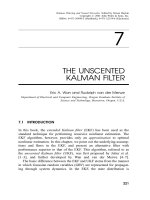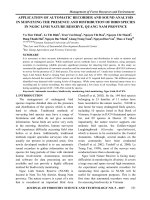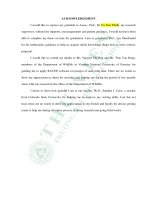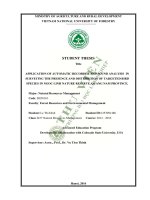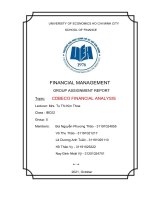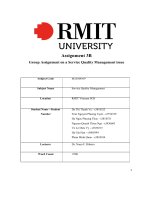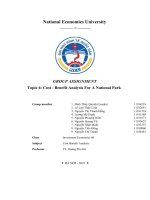Group Assignment [Mkt101] Macro-Environment And Micro-Environment Analysis Coupled With The Business Model (B2C.pdf
Bạn đang xem bản rút gọn của tài liệu. Xem và tải ngay bản đầy đủ của tài liệu tại đây (1.95 MB, 13 trang )
<span class="text_page_counter">Trang 1</span><div class="page_container" data-page="1">
<b>FPT UNIVERSITY- CAMPUS CAN THO</b>
<b>GROUP ASSIGNMENT [MKT101]</b>
<b>Course: MKT101 </b>
Name: Do Thi Anh ThuBui Thi Hong Tuoi Nguyen Thi My Hao Pham Nguyen Minh Thu Pham Diep Kim Ngan Nguyen Huynh Ngoc Tran Class: IB1703
Lecturer: Nguyen Vu Thai Anh
<b>Cần Thơ, October/2022</b>
</div><span class="text_page_counter">Trang 2</span><div class="page_container" data-page="2">1
</div><span class="text_page_counter">Trang 3</span><div class="page_container" data-page="3"><b>I.INTRODUCTION</b>
</div><span class="text_page_counter">Trang 5</span><div class="page_container" data-page="5"><b>II.Macro-environment and Micro-environment analysis coupled with the Business Model (B2C)</b>
<b>1. Macro-environment</b>
Macro-environment consists of the larger societal forces that affect themicroenvironment. There are six stages of macro-environment includedemographic, economic, natural, technological, political, and cultural (Kotler,2017).
<b>a. Economic environment:</b>
The economy around the world tends to recover and the Asia region is predicted tobe the fastest-growing economic region in the world. According to the AsianDevelopment Bank (ADB), the European economy of Asia (excluding Japan)grew by 3.4% in 2009, and in 2010, Asian economies will grow by about 6%.Vietnam's economy in the first quarter of 2009 will grow by 3.1% and forecast aspredicted by economists, our country's GDP this year will be 4.6%, Europe alsoprospers as a compact and efficient economy. Economic growth contributes toimproving people's living standards, leading to an increase in spending, makingAsia and Latin America potential and attractive markets.
<b>b. Technological environment:</b>
Technology is becoming more and more a key factor determining the success orfailure of the company. Pepsi is always looking for ways to deliver services andinformation with high quality and efficiency, global technological developmentsbring possibilities and solutions for Pepsi's growth, always looking for anysolution that can reduce the cost of getting products to customers and improveservice at the same time is one of the company's top goals. Every year, scientistsaround the world have launched millions of inventions in science and technology,bringing real convenience to people's lives. Simultaneously with the developmentof information technology, which has supported the strict management and controlof business activities in different markets, attracting customers through theadvertising system can appear anytime, anywhere. which supports quick decision-making. Technology is increasingly becoming a key factor determining the successor failure of a company.
<b>c. Cultural environment:</b>
Our country is one of the most peaceful countries in the world, with cultural ideasthat must be said to be "open". As for the beverage market, our country will notask too much when the Vietnamese culture does not discriminate against thisproduct line, and so does Pepsi. A new trend that needs to be mentioned here is thefocus on consumer health along with the increase in income. Customers are moreand more concerned about their health, therefore, product innovation is limited.Fat is an important issue to satisfy customers.
<b>d. Political environment:</b>
</div><span class="text_page_counter">Trang 6</span><div class="page_container" data-page="6">Along with the development of the country's economy, Vietnam's legal system isbecoming more and more complete, with more and more barriers and stricterprinciples. That poses bigger challenges for PepsiCo Vietnam's leaders, whichmust be in line with the law and with the company's development spending.Moreover, the business environment in Vietnam is increasingly favorable. morefavorable, due to having very peaceful politics compared to other countries in theregion. In the process of globalization, a series of countries have implemented thepolicy of opening their economy, and accordingly, the legal system is constantlyimproving, and improving "franchising" is considered an effective business formhigh for companies in a distributed industry.
<b>e. Demographic environment:</b>
The results of the 2009 Population and Housing Census show that Vietnam iscurrently the third most populous country in ASEAN and the 13th in the world,specifically 85,789,573 people. Pepsi's main serving audience is young people,Pepsi has actively invested in exploiting the abundant and cheap labor market inorder to create jobs for the young team and also a potential consumer marketcurrently. However, the problem of recruiting, training, and retaining peoplerequires the company to spend a large amount of money combined with a varietyof management forms to meet the changing workforce. Rapid population growthleads to a rapid increase in demand, so Pepsi is most likely to develop, especiallynow that the breath of life is very urgent, a product that ensures both nutrition andmuch-needed convenience. opportunity for Pepsi.
<b>f. Natural environment:</b>
Vietnam is a relatively convenient place for long-term production and businesswithout suffering many disasters or natural disasters… Vietnam is located on theIndochina peninsula, the center of Southeast Asia, with convenient transportationalon the coastline. 3,260 km long excluding islands. Thanks to Vietnam's favorablegeographical position, Pepsi easily trades with partners nationwide as well as inthe region and around the world by land, waterway, and air. However, the South-North distance is quite large (1650km), so the distribution and supply of productsto the North market face many difficulties in terms of transportation costs, andproduct promotion, requiring the company to have a strategy. Vietnam's climate ischaracterized by a tropical monsoon climate with high average temperature, whichmakes the demand for refreshments of people throughout the territory very high,providing Pepsi a large consumption market with a large number of passengers.On the other hand, the tropical monsoon climate also provides the company withabundant water and abundant natural materials. In addition, due to the influence ofthe monsoon, and the complexity of the topography, Vietnam's climate has largedifferences between times of the year and between regions, making it difficult tostudy the products of businesses.
<b>2. Micro-environment </b>
The micro-environment consists of the actors close to the company that affects itsability to serve its customers, the company, suppliers, marketing intermediaries,customer markets, competitors, and publics (Kotler, 2017).
<b>a. The Company</b>
Pepsi is a leading global food and beverage group with 22 brands, generatingapproximately $1 billion in annual retail sales, and its products are distributed in
</div><span class="text_page_counter">Trang 7</span><div class="page_container" data-page="7">more than 200 countries. increase, resulting in annual net sales of US $43.3billion.
- In April 2013, Suntory PepsiCo Vietnam (SPVB) was born with 100% foreigncapital formed through a joint venture between Suntory Group (Japan) andPepsico (USA).
- The year 2015:
+ Revenue is 63,056 billion US dollars+ Operating profit is US $8.353 billion+ Real profit is 5.452 billion USD+ Total assets are 69,667 billion USD+ Total equity of $11.923 billion in the US+ Number of employees is 263,000
<b>b. Suppliers</b>
Pepsi's ingredient suppliers include:
- Sugar: Bien Hoa Sugar Company, Bour Tay Ninh Company- Plastic bottles: Ngoc Nghia Company
- Plastic lid: San Miguel Phu Tho Company, Hercules Vietnam Company- High-grade cartons and paper boxes: Bien Hoa Packaging Company, Dynaplast Packaging (Vietnam) Co., Ltd., Yuen - Foong Yu Company
- Workshop materials: GSI Vietnam Industrial Equipment Co., Ltd- Fragrance: Cork Ireland Company (Ireland)
Suppliers are an important element of the company, so maintaining a good relationship and long-term cooperation with them is indispensable. Because it can help businesses limit input costs, both sides benefit.
<b>c. Marketing intermediariesd. Customers</b>
Along with the development of the economy, people's lives are improved, and customers are more and more interested in the need to "eat well and dress well" but must ensure their own health. Beverage and food market convenience food is growing, and competitors providing products are more and more diversified according to the trend of increasing the volume and quality of products, the qualityof life is improved, increasing the influence of consumers. It is easier and easier for customers to choose and compare products between competitors to choose for themselves the best and most suitable product.
<b>e. Competitors</b>
Pepsi's competitors are of two types:
- Direct competitors: Tan Hiep Phat, Red Bull, Tribeco, and arch-rival Coca-Cola. The battle between Pepsi and Coca-Cola still shows no sign of stopping, always confronting each other anytime, anywhere.
- Potential competitors: start-ups or businesses specializing in the production of substitute products such as coffee, milk, and bottled water. Therefore, the threat of these substitutes puts great pressure on Pepsi to consider and come up with appropriate strategies.
<b>f. Publics</b>
To promote its brand, Pepsi regularly organizes activities such as:
- The Water Hope clean water supply project aims to create jobs and increaseincomes for people in Quang Nam province.
</div><span class="text_page_counter">Trang 8</span><div class="page_container" data-page="8">- Accompanying the "Summer Volunteer Campaign" to organize environmentalprotection activities such as cleaning up the coast of Vietnam or Supporting theexam season...
- Invite celebrities to be spokespeople like BLACKPINK, Messi, My Tam, SonTung MTP...
- The campaign "Bring Tet home" attracted great attention from consumers whenPepsi launched a meaningful Tet campaign with the message of helpingdisadvantaged people to return home to celebrate Tet.
Thanks to the regular organization and implementation of these activities as wellas the wide coverage in the media, the company has made a good impression inthe hearts of consumers and the company's stock price has also increasedaccordingly.
<b>3. Business Model (B2C)</b>
Pepsi is the second largest soft drink company in the world with strong financialresources. Pepsi always has new initiatives to create new products to meet theincreasingly diverse needs of consumers. Pepsi's sales distribution system is spread allover the country.
Pepsi company also owns a business model in the form of B2C. The companysupplies products directly from the manufacturer to retail stores. The company alsoincludes direct delivery workers at snack and beverage stores. Pepsi distributesproducts through traditional marketing channels, products are often sold to consumersthrough intermediaries such as retailers and agents. There are also advertisingmethods, and customer conferences to introduce products to consumers. Productsalways know how to hit consumer psychology to make an impression on newcustomers. Besides, Pepsi has succeeded in designing and creating a website thatattracts people's attention. The design of the website includes many eye-catchingcolors, shapes, and font sizes to promote products, tweets and photos shared on socialnetworks. This website plays a role in connecting customers and businesses. Thewebsite was created with the purpose of providing information related to Pepsi fromits history, mission, and slogan to old products and new products launched. Pepsi alsodistributes products to all corners of the world, products can easily be found inconvenience stores, grocery stores, vending machines, etc. Through this, it can beseen that Pepsi is a large soft drink company that is not limited in size.
<b>III.Consumer behavior analysis and how the company executedsegmentation, differentiation, targeting, and positioning.</b>
<b>1. Consumer behaviora. Cultural factors:</b>
Many subcultures make up important market segments, and marketers oftendesign products. For Pepsi company, subculture is very important in influencingconsumers to buy their products. They need to target consumers based on theirnationality, religion, racial group, and geographic area. As for nationality, Pepsimust be aware of any countries that do not allow their people to drink soft drinks.
<b>a. Social factor: </b>
Including organizations such as religions and professional associations ... Pepsiwill easily attract them to buy more products because members have an influenceon each other. Family is an important purchasing organization. Marketers are
</div><span class="text_page_counter">Trang 9</span><div class="page_container" data-page="9">interested in the role and influence of family members. Pepsi needs to targetchildren because they are the ones who will consume more Pepsi. But for reasons,they will ask the parents to buy the product. So, parents are customers andChildren are consumers.
<b>b. Personal factors:</b>
There are many factors that affect the purchase such as occupation, income, andage, ... Therefore, Pepsi needs to find a thing or a person to influence them. Forexample, advertising is their best tool to influence them, or for parents andchildren their best factor to influence them to buy Pepsi products.
- Psychological principles: Pepsi products choose for themselves the middle-classsegment with a loving and active lifestyle.
- Principle of behavior: Used for daily refreshments, holidays, parties… Withfrequent intensity and high loyalty.
- Demographic principle: With 57% of Vietnam's population under the age of 26, itproves that Vietnam is a potential market for Pepsi. Pepsi captured this segment bylaunching Pepsi-Cola and it was extremely successful.
<b> 3. Market Target</b>
- In the 1950s, Pepsi targeted young people with the name "Pepsi Generation". Thecompany sacrifices all types of markets except the youth market. And the sloganwhen it's "Let's get along - drink Pepsi".
- Pepsi has tried to create more attractive, and suitable for consumers thancompeting brands. Thanks to this strategy, Pepsi products have developed andmaintained an important basic identity image. Pepsi's products in the Vietnamesemarket still hold onto the market and its target is young customers.
<b> 4. Positioning</b>
- Target customers: From the very beginning, Pepsi's mission is for young people.Targeting the audience on Pepsi has favored its products from the taste to thenecessary marketing methods to go deep into the hearts of consumers. With astrong sweet taste and a large amount of gas, it gives users a new feeling, differentfrom other products on the market.
- Benefits Pepsi brings to consumers: the first is to quench thirst, stimulatenovelty, and create a feeling of excitement and excitement for users. Pepsi helpsyoung people express their youth, dynamism, and new style.
<b> 5. Differentiation</b>
- About products: Pepsi's sweet and strong taste is suitable and popular in Vietnam.In addition, Pepsi also distributes to fast food stores such as KFC, and Pizza Hut...Therefore, Pepsi won a high market share in Vietnam.
- About services: Pepsi organizes advertising shows on television, and haspromotions such as "Drink Pepsi Turn on the winning cap", and "Drink Pepsi -Win a Honda".
</div><span class="text_page_counter">Trang 10</span><div class="page_container" data-page="10">- About people: Pepsi's employees are selected with high criteria and capacity.Many remuneration regimes are commensurate with employees' qualifications.More importantly, Pepsi employees always have the number one subconsciousmind about the Pepsi brand, which is the motivation for employees to strive anddo their best for the company.
<b>IV.The elements of 4P (Price/Product/Promotion/Place)1. Product</b>
- Pepsi products thrive in the current context when many people have busy work,so they often prefer to use fast food and carbonated drinks. In addition,convenient products, refreshments, good digestion ... should be loved by manypeople.
- Besides sugary products, Pepsi also launched zero sugar, zero calories Pepsiproducts, and diet Pepsi exclusively for dieters.
- Packaging is very diverse such as glass bottles, plastic, and cans with differentcapacities from 300ml, 500ml, and 1500ml for consumers to choose freely.Information about ingredients, production address, production date, and expirydate are fully recorded by Pepsi on the package.
<b> 2. Price</b>
Pepsi chose a relatively low new product pricing strategy to enter the market inthe hope of attracting a large number of customers and capturing a large marketshare.
- Discount Pricing: Pepsi offers discounts to customers who buy in bulk, payahead of time, or pay now. Therefore, the more customers buy in quantity, thelarger the discount.
- Differentiated pricing by product: depending on different product lines, anddifferent capacities, from which Pepsi will have an appropriate price for
<b>customers to choose. </b>
<b> 3. Place</b>
Pepsi's distribution channels are diverse. Pepsi cooperates with supermarkets suchas Big C, Mega, Aeon, and Lotte Mart and fast food stores such as KFC, Lotteria,McDonald's, Pizza Hut, and cinemas. Besides, agents and retail outlets areimportant distribution channels for this brand. Thanks to these distributionintermediaries, Pepsi saves time, and costs and reaches consumers easily.
<b> </b>
<b> 4. Promotion</b>
The promotion strategy is the means to bring Pepsi closer to consumers andachieve huge sales. In the process of implementing the marketing strategy, Pepsihas grasped and understood each consumer's Know - Understand - Like - Like -Believe and Buy Thai camps. Pepsi has implemented many communitycontribution activities in order to PR for the brand to bring the brand closer toconsumers thanks to the campaign "Drink a can of Pepsi is to spend 50 dong tosupport flood victims". This campaign during that time was very successful.Deploying attractive promotions such as buying 2 cartons of Pepsi with 24 canswill get 1 box of Pepsi 8 gold cans for free, on the occasion of Tet 2021.
<b>V.Advertising and Public Relations Communication analysis (IMC).1. Advertising</b>
</div>